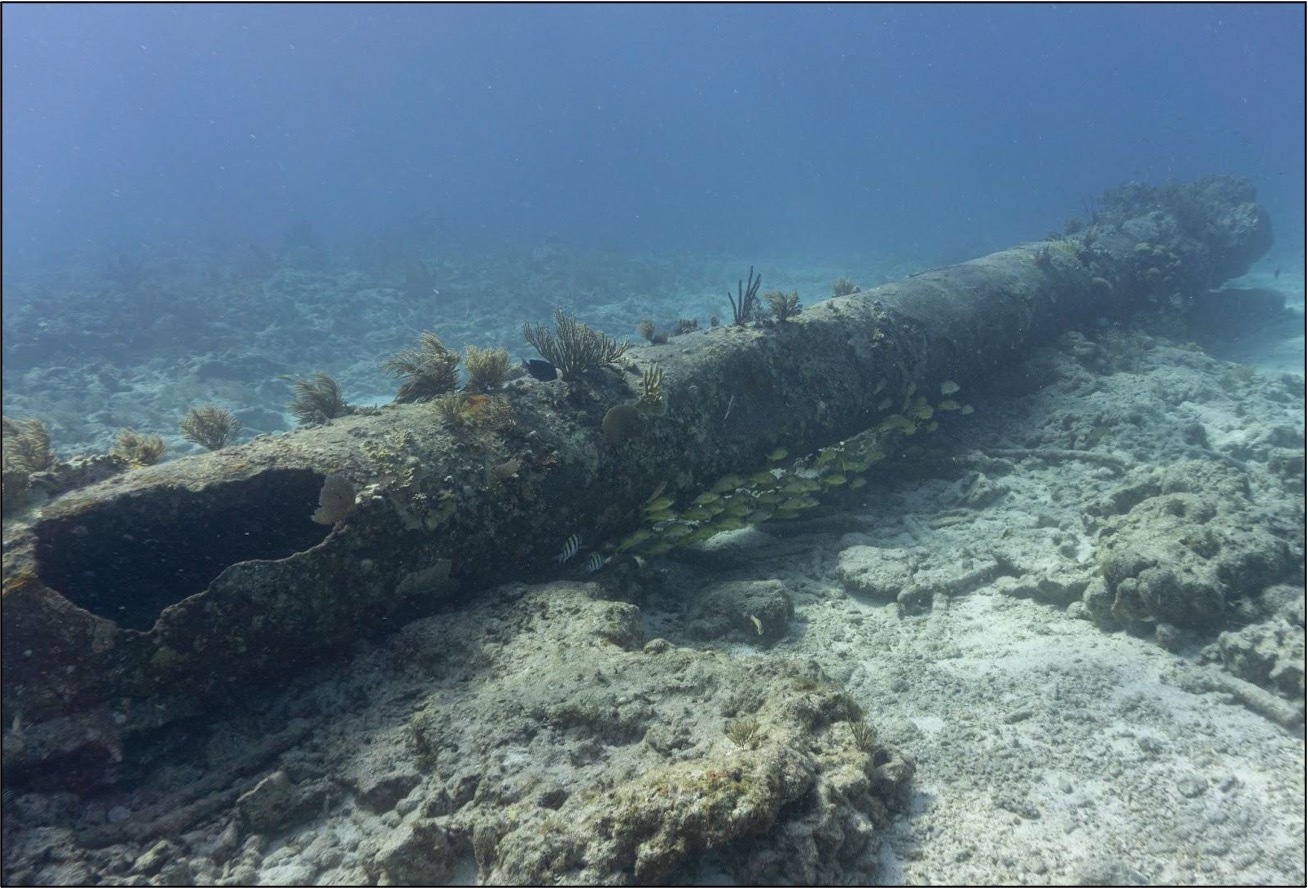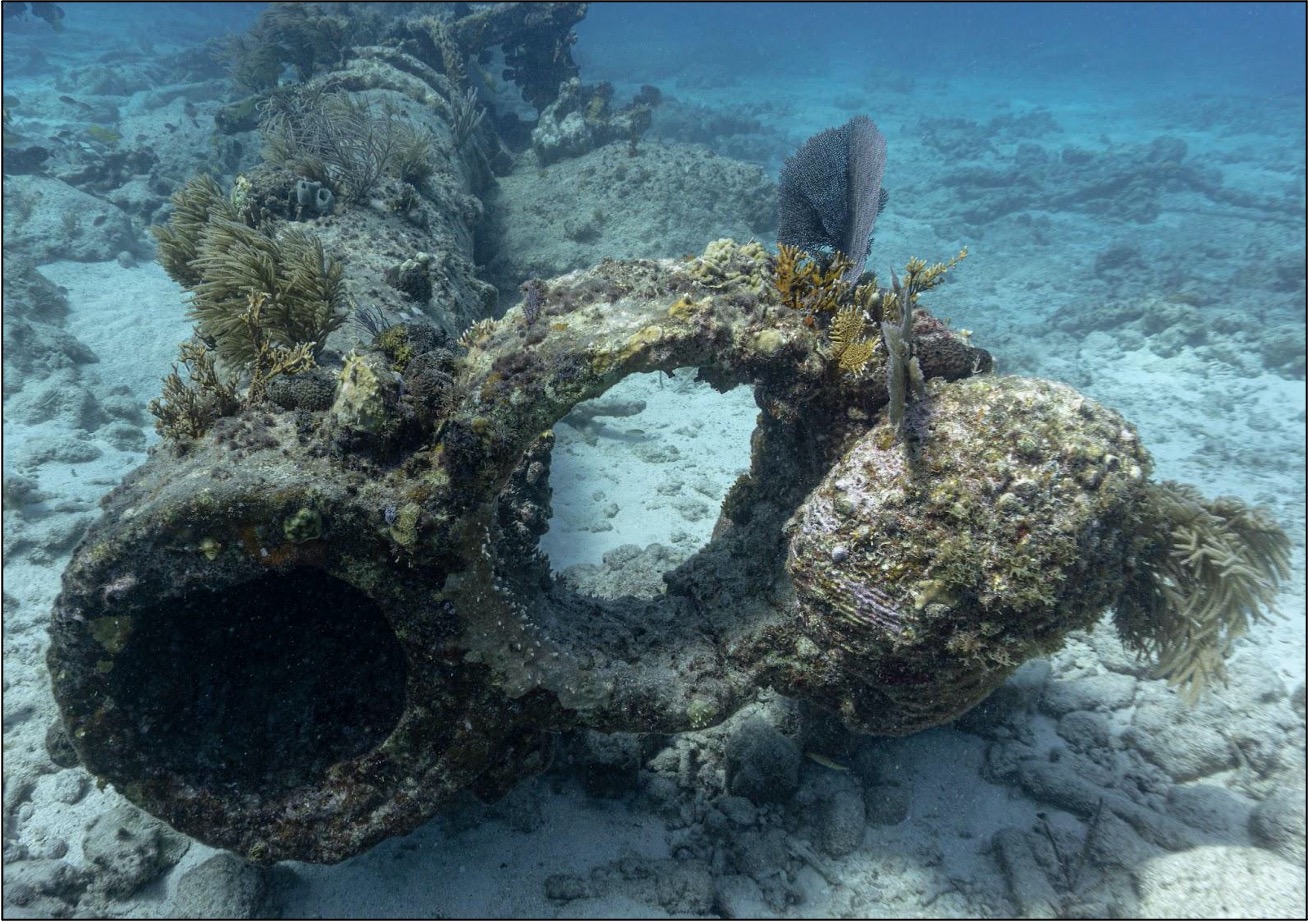Associated Biology
General Habitat: Located within Molasses Reef, but there is not much large upstanding reef structure in the close vicinity of the site, mainly flatter reef and sandy areas.
Benthic Habitat: The archaeological site features, principally the mast component, provide an excellent benthic habitat for many biological species within the coral reef ecosystem. The metal of the mast provides a substrate for coral and other invertebrate growth, the mast itself provides shelter for fish that school alongside it, and a habitat/home for a green moray eel living inside of it. The other various archaeological features provide habitat for marine life, but to a lesser extent. For example, a Caribbean Spiny Lobster was observed taking shelter inside of an artifact that may have been part of the ship’s rudder or water assembly. 23 species of fish were observed and identified on the site, along with 14 species of invertebrates.
Structural Complexity: The archaeological site features provide substrate for coral and other associated biological growth, but there is not much relief to the reef in the area around this site.
Biological Monitoring Stations: Not currently any official BMS on this site.
Noted Damage to Biota: Some coral bleaching present. Old breakage of stony corals present.
Hazards to Biota: Visiting recreational divers, storms, boat anchors, climate change.
Mast Diversity
The south end of the mast features a large diversity of biological growth. All across this section of the mast is healthy Orbicella faveolata (mountainous star coral) and Millepora complanata (bladed fire coral). On the east side of the end of the mast, an iron knee is attached to the mast via concretion as the wreck site formed. This knee boasts a healthy colony of Montastrea cavernosa (great star coral) with large, colorful polyps. There is also a colony of Porites astreoides (mustard hill coral), but it was noted to be bleached. Coral bleaching occurs when environmental conditions, such as raised ocean temperatures from climate change, causes the animal’s symbiotic zooxanthellae to be expelled. Zooxanthellae is a type of dinoflagellate algae that not only gives a coral its bright colors, but produces carbohydrate nutrients for the coral via photosynthesis. Without the zooxanthellae, corals are even more vulnerable to other environmental changes, such as increased sedimentation and nutrients, and ocean acidification. However, the Brass Pin Wreck site still seems to be a bright spot for coral reefs, attracting a variety of coral, invertebrates, and vertebrates. Where the coral is in great quantity on the end of the mast, many fish were observed swimming nearby.
For coral growth in a particular environment, they need a stable, raised substrate in order for larval attachment, settlement, and development to occur. Even though the site is located within Molasses Reef, there is not much upstanding reef structure and relief in the area around this site. Here, the mast acts as a substrate for coral and other associated biological growth, including encrustations and soft corals such as sea fingers, sea whips, and sea fans.
Univeristy research shows that compared to the assessment of the south end of the mast in 2005, there is much more biological growth in 2021 (Muckerheide, 2021).
Mast Partner
There is a mast partner attached to the mast at the north end of the artifact. In sailing, the mast partner is used to attach an extension to the mainmast. In this case, the extension was made of wood and has deteriorated, so it is not present on the site. Currently, there is dead brain coral (Pseudodiploria strigosa) covered by algae attached to the partner, along with some sea fans. From a biological survey taken of the site in 2005, this brain coral was large and healthy. Research shows that there is a considerable amount of sand change present on the site, occurring from storms and other water movements, which work to bury and unearth artifacts as sand is deposited and removed. This comparison highlights the importance of establishing regular biological monitoring on this shipwreck site, particularly as it continues to show some resilience in the face of climate change, as indicated by the impressive biota on the broken south end of the mast (Muckerheide, 2021).



